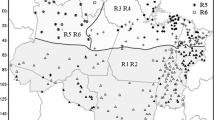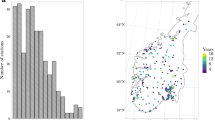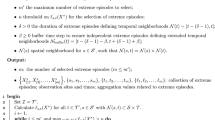Abstract
Present day weather forecast models usually cannot provide realistic descriptions of local and particularly extreme weather conditions. However, for lead times of about 0–5 days, they provide reliable forecasts of the atmospheric circulation that encompasses the sub-scale processes leading to extremes. Hence, forecasts of extreme events can only be achieved through a combination of dynamical and statistical analysis methods, where a stable and significant statistical model based on a-priori physical reasoning establishes a-posterior a statistical-dynamical model between the local extremes and the large scale circulation. Here we present the development and application of such a statistical model calibration on the basis of extreme value theory, in order to derive probabilistic forecasts for (extreme) local precipitation. Besides a semi-parametric approach (censored quantile regression, QR) to derive conditional quantile estimates, we use a Poisson point process representation (PP) with non-stationary parameters but a constant threshold, and a peak-over-threshold representation (POT) using the non-stationary generalized Pareto distribution and a variable threshold. The variable threshold is conditioned on the numerical model output and defined as the 0.95 conditional quantile. The performance of the different approaches is compared using the quantile verification score. The downscaling applies to ERA40 re-analysis, in order to derive estimates of the conditional quantiles of daily precipitation accumulations at German weather stations. In terms of the verification score, the differences between the downscaling approaches are marginal. However, the uncertainty of the quantile estimates is larger for the semi-parametric QR approach, particularly for the high quantiles. A constant shape parameter is to be preferred for a stable statistical downscaling model.
Similar content being viewed by others
References
Alexander, L.V., et al.: Global observed changes in daily climate extremes of temperature and precipitation. J. Geophys. Res. 111, D05,109 (2006). doi:10.1029/2005JD006290
Beirlant, J., Goegebeur, Y., Segers, J., Teugels, J.L.: Statistics of Extremes. Wiley, Chichester (2004)
Bremnes, J.B.: Probabilistic forecasts of precipitation in terms of quantiles using NWP model output. Mon. Weather Rev. 132, 338–347 (2004)
Coles, S.: An Introduction to Statistical Modeling of Extreme Values. Springer Series in Statistics. Springer, London (2001)
Embrechts, P., Klüppelberg, C., Mikosch, T.: Modelling Extremal Events for Insurance and Finance. Springer, Berlin (1997)
Embrechts, P., Klüppelberg, C., Mikosch, T.: Modelling Extremal Events for Insurance and Finance. Springer, Berlin (2003)
Fahrmeir, L., Tutz, G.: Multivariate Statistical Modelling Based on Generalized Linear Models. Springer Series in Statistics. Springer, New-York (1994)
Fisher, R.A., Tippett, L.H.C.: On the estimation of the frequency distributions of the largest or smallest member of a sample. Proc. Camb. Philol. Soc. 24, 180–190 (1928)
Fowler, H.J., Kilsby, C.G.: Implications of changes in seasonal and annual extreme rainfall. Geophys. Res. Lett. 30, 1720 (2003). doi:10.1029/2003GL017327
Frei, C., Schär, C.: Detection probability of trends in rare events: theory and application to heavy precipitation in the Alpine region. J. Climate 14, 1568–1584 (2001)
Frich, P., Alexander, L.V., Della-Marta, P., Gleason, B., Haylock, M., Klein Tank, A.M.G., Peterson, T.: Observed coherent changes in climatic extremes during the second half of the twentieth century. Clim. Res. 19, 193–212 (2002)
Friederichs, P., Hense, A.: Statistical downscaling of extreme precipitation events using censored quantile regression. Mon. Weather Rev. 135, 2365–2378 (2007)
Friederichs, P., Hense, A.: A probabilistic forecast approach for daily precipitation totals. Weather Forecast. 23, 659–673 (2008)
Friederichs, P., Paeth, H.: Seasonal prediction of african precipitation with echam4-t42 ensemble simulations using a multivariate mos prediction scheme. Clim. Dyn. 27, 761–786 (2005). doi:10.1007/s00382-006-0154-4
Gnedenko, B.: Sur la distribution limite du terme maximum d’une serie aléatoire. Ann. Math. 44, 423–453 (1943)
Gneiting, T., Raftery, A.E.: Strictly proper scoring rules, prediction, and estimation. J. Am. Stat. Assoc. 102, 359–378 (2007)
Gumbel, E.J.: Statistics of Extremes. Columbia University Press, New York (1958)
Hamill, T.M., Whitaker, J.S., Wei, X.: Ensemble re-forecasting: improving medium-range forecast skill using retrospective forecasts. Mon. Weather Rev. 132, 1434–1447 (2004)
He, X.: Quantile curves without crossing. Am. Stat. 51, 186–192 (1997)
Heuer, K.O.: Analyse täglicher Extremniederschläge in Deutschland mit Hilfe der Extremwertstatistik. Diplomarbeit, Meteorologisches Institut, Rheinischen Friedrich-Wilhelms-Universität Bonn (2006)
Katz, R.W., Parlange, M.B., Naveau, P.: Statistics of extremes in hydrology. Adv. Water Resour. 25, 1287–1304 (2002)
Kharin, V.V., Zwiers, F.W.: Changes in the extremes in an ensemble of transient climate simulation with a coupled atmosphere-ocean GCM. J. Climate 13, 3760–3788 (2000)
Kharin, V.V., Zwiers, F.W., Zhang, X., Hegerl, G.C.: Changes in temperature and precipitation extremes in the IPCC ensemble of global coupled model simulations. J. Climate 20, 1419–1444 (2007)
Koenker, R.: Quantile Regression. Econometric Society Monographs, vol. 38. Cambridge University Press, Cambridge (2005)
Koenker, R., Bassett, B.: Regression quantiles. Econometrica 46, 33–49 (1978)
Koenker, R., Machado, J.A.F.: Goodness of fit and related inference processes for quantile regression. J. Am. Stat. Assoc. 94, 1296–1310 (1999)
Mason, S.J., Galpin, J.S., Goddard, L., Graham, N.E., Rajartnam, B.: Conditional exceedance probabilities. Mon. Weather Rev. 135, 363–372 (2007)
Mudelsee, M., Börngen, M., Tetzlaff, G., Grünewald, U.: No upward trends in the occurrence of extreme floods in central Europe. Nature 425, 166–169 (2003)
Murphy, A.H.: Hedging and skill scores for probability forecasts. J. Appl. Meteorol. 12, 215–223 (1973)
Nelder, J.A., Mead, R.: A simplex algorithm for function minimization. Comput. J. 7, 308–313 (1965)
Neyman, J., Scott, E.L.: Some outstanding problems relating to rain modification. In: Proc. 5th Berkeley Symp. Math. Statist. Prob., vol. 5, pp. 293–326 (1967)
Osborn, T.J., Hulme, M.: Evidence for trends in heavy rainfall events over the United Kingdom. Philos. Trans. R. Soc. Lond. Ser. A 360, 1313–1325 (2002)
Pickands, J.: The two-dimensional Poisson process and extremal processes. J. Appl. Probab. 8, 745–756 (1971)
R Development Core Team: R: A language and environment for statistical computing. http://www.R-project.org (2003)
Resnick, S.: Extreme Values, Regular Variation, and Point Processes. Springer, New York (1987)
Schmidli, J., Frei, C., Vidale, P.L.: Downscaling from gcm precipitation: a benchmark for dynamical and statistical downscaling methods. Int. J. Climatol. 26, 679–689 (2006)
Uppala, S.M., et al.: The ERA-40 re-analysis. Q. J. R. Meteorol. Soc. 131, 2961–3012 (2005)
Vrac, M., Naveau, P.: Stochastic downscaling of precipitation: from dry events to heavy rainfalls. Water Resour. Res. 43, W07402 (2007a). doi:10.1029/2006WR005308
Vrac, M., Paillard, D., Naveau, P.: Non-linear statistical downscaling of present and LGM precipitation and temperatures over europe. Climate of the Past Discussions 3(4), 899–933 (2007b)
Widmann, M., Bretherton, C.S., Salathé, E.P.: Statistical precipitation downscaling over the Northwestern United States using numerically simulated precipitation as a predictor. J. Climate 16, 799–816 (2003)
Wilks, D.S., Hamill, T.M.: Comparison of ensemble-MOS methods using GFS reforecasts. Mon. Weather Rev. 135, 2379–2390 (2007)
Yu, K., Moyeed, R.A.: Bayesian quantile regression. Stat. Probab. Lett. 54, 437–447 (2001)
Zwiers, F.W., Kharin, V.V.: Changes in the extremes of the climate simulated by CCC GCM2 under CO2 doubling. J. Climate 11, 2200–2222 (1998)
Author information
Authors and Affiliations
Corresponding author
Rights and permissions
About this article
Cite this article
Friederichs, P. Statistical downscaling of extreme precipitation events using extreme value theory. Extremes 13, 109–132 (2010). https://doi.org/10.1007/s10687-010-0107-5
Received:
Revised:
Accepted:
Published:
Issue Date:
DOI: https://doi.org/10.1007/s10687-010-0107-5




